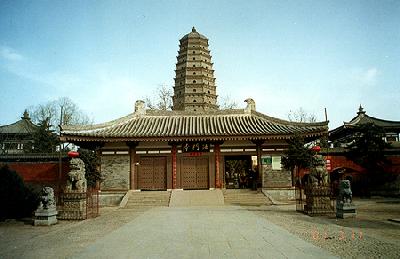|

Famen Temple is situated at Famen Town, ten kilometers north of Fufeng County, Shaanxi Province, China. It is a famous Buddhist temple with a long history, and became a Holy Land of Buddhism because the finger bone relic of Sakyamuni was placed in it.
Famen Temple was built in the Eastern Han Dynasty (25-220). According to the Buddhist scriptures, in 272BC, King Asoka of India presented relics of Buddha to different places in order to carry forward Buddhist doctrines. All places receiving such relics must build pagodas to enshrine them; therefore, 84,000 pagodas were built all over the world. There are 19 such pagodas in China, among which Famen Temple is the largest one. Therefore, Famen Temple is also called King Asoka Temple. Its prosperity began from the Northern Wei Dynasty (386-534), and reached the peak in the Sui and Tang dynasties (581-907), when it was reputed as an imperial temple. Eight emperors of the Tang Dynasty welcomed several times bone relics of Buddha back to the palace for worship, and awarded a large amount of treasure to the temple, which was stored at its underground palace.
In Famen Temple stands a 13-storeyed pagoda. It was dilapidated for a long period. In 1987, the government decided to rebuild it. In the course of cleaning up the pagoda's base, an underground palace of the Tang Dynasty, which had been closed for one thousand years, was excavated. This is the largest underground palace in pagodas found in China so far in which finger bone relic of Buddha and batches of precious cultural relics of the Tang Dynasty are treasured up. The finger bone relic of Buddha found here, tooth relic of Buddha in Lingguang Temple, Badachu (Eight Great Sites) and Xishan Mountain of Beijing City, and tooth relic of Buddha in Buddha's Tooth Relic Temple in Kandy, Sri Lanka, are the only three extant relics of the real body of Sakyamuni in the world. This discovery is very significant, following the discovery of terracotta warriors and horses of the First Emperor of the Qin Dynasty (221-206BC).
The rehabilitated Famen Temple stands at Famen Town with a brand-new appearance. But its general layout -- pagoda front and hall behind -- still follows that of the early Tang Dynasty (628-907). The pagoda keeps the old style of the Ming Dynasty's brick towers, and becomes the symbol of Famen Temple. The main building of the temple is the Treasure Hall, where rare national cultural relics are exhibited.
|

